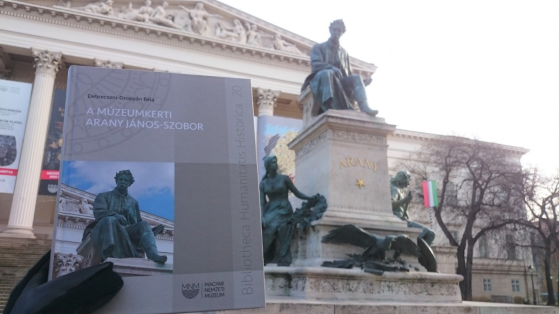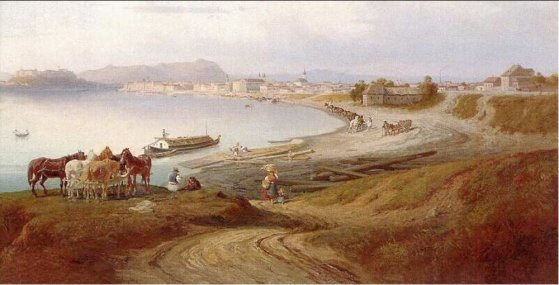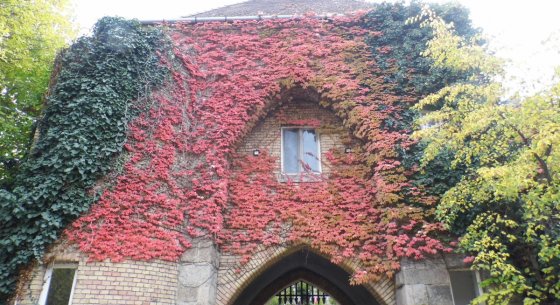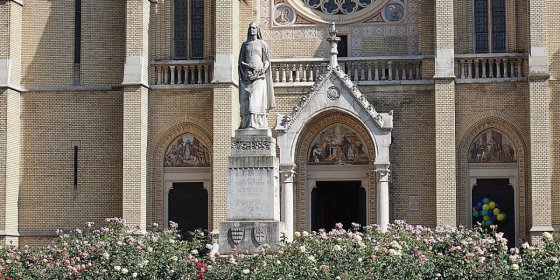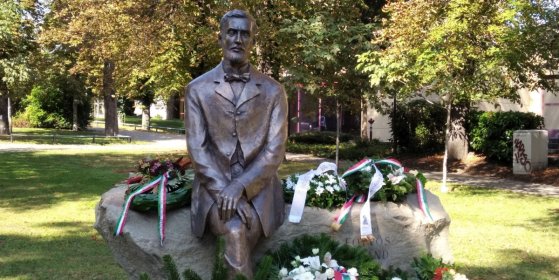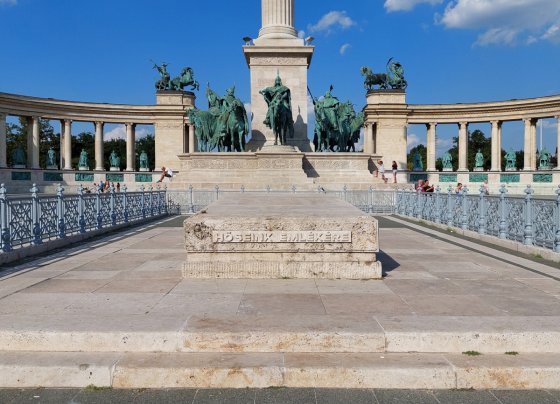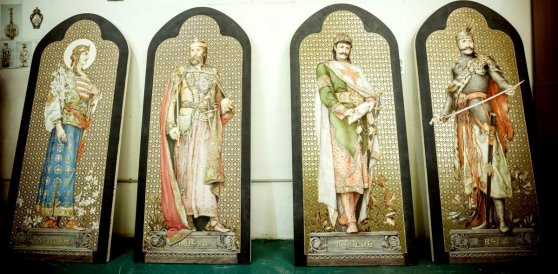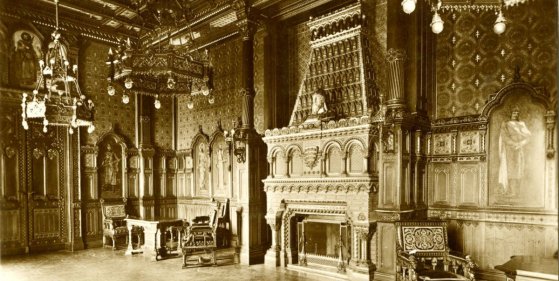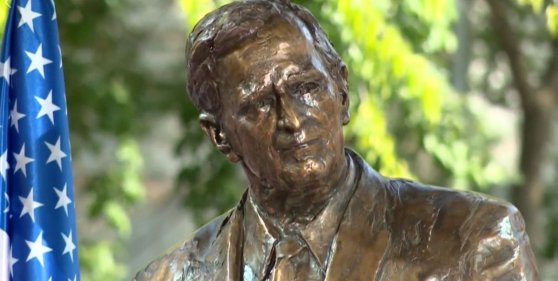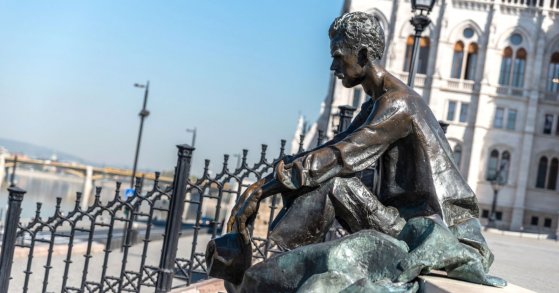 The „intertwined history” of the bridges and the city of Budapest
Which ideas and events have shaped the fate of bridges of Budapest and the cityscape? Alongside many other interesting facts, this question is also answered this newly published book by the Budapest City Archives, which introduces the history of bridges in Budapest.
The „intertwined history” of the bridges and the city of Budapest
Which ideas and events have shaped the fate of bridges of Budapest and the cityscape? Alongside many other interesting facts, this question is also answered this newly published book by the Budapest City Archives, which introduces the history of bridges in Budapest.
Arts
 Who also painted the construction of the Chain Bridge: Miklós Barabás died 125 years ago
Who also painted the construction of the Chain Bridge: Miklós Barabás died 125 years ago
February 17, 2023 at 12:30 PM
We can confidently say that Miklós Barabás was one of the most outstanding artists of the Reform era, the first painter who earned the respect of society with his artistic work. During his long career, he made portraits of many important and well-known personalities, including Mihály Vörösmarty, János Arany, Ferenc Deák, Palatine Joseph, and even Franz Joseph. The capital also often provided the subject of his pictures. He achieved great success with his paintings, and the press regularly reported on his current works. It was thanks to his exceptional talent that he managed to gain fame at a time when the work of painters was not yet highly valued.
The meeting of a unique sculptor and the cult of Arany - Description of a period with the help of a 130-year-old famous monument in Pest
January 31, 2023 at 9:00 AM
130 years ago the first public statue of János Arany was inaugurated in front of the main entrance of the Hungarian National Museum. In a new book that has just been published, not only is the entire history of the monument and the adventurous life of its creator, Alajos Stróbl, revealed to the readers, but they can also see how the people of the 19th century thought and debated, what they considered beautiful and right, what they were different from or just similar to people now. The book, which is also rich in images, is both a colourful introduction and an exciting description of a period.
Who painted Pest and Buda several times: Antal Ligeti was born 200 years ago
January 30, 2023 at 4:00 PM
Antal Ligeti, born 200 years ago, was one of the outstanding figures of Hungarian painting. He lived in extraordinary places, first in the Fót castle of Count Károlyi István, later in Budapest's most famous classicist palace: the National Museum building. He owed his first home to the support of the lord, who recognised the talent of the young painter and provided him with housing and board as a patron. He earned his home in the building of the National Museum as the keeper of the picture gallery, lived there for more than twenty years, and was taken to the cemetery from there.
Art Nouveau on tombstones - An attempt to renew cemetery art
November 2, 2022 at 10:00 AM
Around the Day of the Dead, many of us visit the graves of our loved ones, and at this time we can discover that the cemetery is also a repository of real works of art. At the beginning of the 20th century, Art Nouveau, which broke with classical forms, permeated this area as well, and artists tried to offer new solutions to those who ordered tombstones. One of the most enthusiastic of them was the sculptor Richárd Füredi, who together with two of his colleagues organised an exhibition to introduce his works reflecting the new taste to the general public.
Sculptor József Damkó was born 150 years ago - His works can be admired all over the capital
October 17, 2022 at 2:00 PM
Undeservedly little is said about sculptor József Damkó, even though the artist produced many works that stand at important points in the Hungarian capital. Such is the statue of Saint Elizabeth of the House of Árpád on Rózsák Square, the statue of St. John of Capistrano on Kapisztrán Square in Buda Castle or the statue of Pope Innocent XI on Hess András Square. His architectural sculptures and tombstones are also of considerable value. Pestbuda now presents the Budapest works of József Damkó on the 150th anniversary of his birth.
Lajos Kossuth's first public statue in Budapest - Special creation in the Zugliget Forest
September 21, 2022 at 11:00 AM
Few people know that at the end of Mátyás Király Road in Zugliget, in the forest, there is a special, 110-year-old statue of Kossuth on a huge pedestal. On the 220th anniversary of the former reformist politician's birth, Pestbuda will show the exact circumstances under which the work of art ended up in the Zugliget Forest, and also examine whether this was really the first public Kossuth Statue in Budapest.
The statue of Ferenc Rákóczi II was unveiled in Kossuth Square 85 years ago
May 5, 2022 at 11:00 AM
The statue of Ferenc Rákóczi II has been standing on Kossuth Square for 85 years now. Its erection was decided on the 200th anniversary of his death, and two years later, in 1937, the statue stood. Since then, only the inscriptions have been changed, sometimes for political or grammatical reasons.
A statue was erected for Loránd Eötvös, who served universal science with a Hungarian heart
October 6, 2021 at 2:00 PM
One of the most famous Hungarian scientists is immortalised in many reliefs and busts in Budapest, but previously he only had one life-sized statue: it was erected in 2016 in Pest, in front of the central building of the University named after him. Now a new statue has been placed in the Gesztenyés Garden in the 12th District of Buda, and the place is closely connected to him as well: his most famous invention, the torsion pendulum was produced in the predecessor of the Hungarian Optical Works operating next door.
The Neuschlosz Brothers created the inlaid parquet floor of the St. Stephen's Hall
September 1, 2021 at 3:30 PM
From 20 August, anyone can visit the rebuilt St. Stephen's Hall in the renewed south connecting wing of the Buda Castle. The beauty and uniqueness of the ballroom are enhanced by its special inlaid parquet flooring. But who created this unique flooring? Take a look at the work of the Neuschlosz Brothers.
Where Mór Jókai and Johann Strauss Jr. met - A fire destroyed the German Theatre in Lipótváros
August 27, 2021 at 12:30 PM
At 24 Báthory Street, 5th District, it can be found out only from a memorial plaque that the German Theatre of Pest once stood here. This was already the third venue for German acting in Pest, but the theatre could not function here for a long time either. Twenty years after its opening, on 20 December 1889, a fire destroyed the building, in which Mór Jókai also turned, and an operetta written from his work was even performed here.
The Memorial Stone of Heroes was torn down 70 years ago
August 26, 2021 at 11:00 AM
In the shadow of the Millennium Monument, another work is hidden in the Heroes' Square. The Memorial Stone of Heroes symbolises a mass grave, originally erected in 1929, in memory of the soldiers of the First World War resting in anonymous graves, but it was not mourning that was its primary message, but mobilisation against the changing millennial boundaries. The memorial stone was demolished in 1951 but re-erected in the spring of 1956 and then in 2001, in a different form and with new messages.
Miklós Borsos, who made the Zero Kilometre Stone, was born 115 years ago
August 13, 2021 at 9:00 AM
Miklós Borsos, who was recognised as a sculptor, medalist and graphic artist, was born on 13 August 1906, in Nagyszeben (today's Sibiu, Romania), Transylvania, 115 years ago. He lived in Győr, and then in Budapest from 1945. In winter, he worked in the Castle District, at 6 Úri Street, and in summer, in Tihany; his permanent museum can be visited in Győr. Several of his works can be seen in Budapest, and a few of his works involuntarily attracts attention.
Painter of saints and kings – Twelve works by Ignác Roskovics adorned Saint Stephen's Hall
June 14, 2021 at 9:00 AM
Ignác Roskovics was one of the popular painters of the last decades of the 19th century and the turn of the century. Among the ecclesiastical and historical works that define his oeuvre, the twelve paintings made for the St. Stephen's Hall in Buda Castle stand out, based on which ceramic paintings were made in the Zsolnay factory. The works, ten of which depict the most important kings and saints of the House of Árpád, and two depict scenes from the life of St. Stephen, will be on display again from 20 August in the recreated St. Stephen's Hall.
"The most lavish fireplace ever made in Hungary"
June 5, 2021 at 10:30 AM
Hardly anyone would doubt that the country’s most famous fireplace stood in the St. Stephen’s Hall of the Royal Palace. Vilmos Zsolnay lived to see the making of the sophisticatedly designed and executed masterpiece made of Zsolnay majolica, but he could no longer supervise its installation: he died not long before. Lucky posterity, however, may soon admire the work destroyed after World War II, as the former masterpieces were rebuilt under the National Hauszmann Program in the reborn St. Stephen's Hall. In this article, Pestbuda looks at the behind-the-scenes of the redesigning of the fireplace.
Statue of George Bush unveiled on Szabadság Square
October 27, 2020 at 2:30 PM
Statue of George H. W. Bush., 41st President of the United States of America, has been unveiled on Szabadság Square. The bronze full-length work was erected alongside a statue of Ronald Reagan.
Poetry Day Walk - Statues of the greatest Hungarian poets in Budapest
April 11, 2020 at 10:00 PM
On this year's National Poetry Day, 11 April - the birthday of Attila József - the public, community poem readings, which have already become a tradition, were cancelled, and we could not even visit the statues of the greatest Hungarian poets to show our respect and gratitude. Thus, Pestbuda offers only a virtual walk between the works depicting our national greats in Budapest.
More articles
 The „intertwined history” of the bridges and the city of Budapest
Which ideas and events have shaped the fate of bridges of Budapest and the cityscape? Alongside many other interesting facts, this question is also answered this newly published book by the Budapest City Archives, which introduces the history of bridges in Budapest.
The „intertwined history” of the bridges and the city of Budapest
Which ideas and events have shaped the fate of bridges of Budapest and the cityscape? Alongside many other interesting facts, this question is also answered this newly published book by the Budapest City Archives, which introduces the history of bridges in Budapest.
 The Bridge Report, which brought a turning point in the history of Budapest
A travel report that changed the history of Pest and Buda, as well as Hungary. The little book contributed to the change of half a thousand years of legal customs and the implementation of an investment of unprecedented size and technical quality. This book was The Bridge Report [Hídjelentés in Hungarian].
The Bridge Report, which brought a turning point in the history of Budapest
A travel report that changed the history of Pest and Buda, as well as Hungary. The little book contributed to the change of half a thousand years of legal customs and the implementation of an investment of unprecedented size and technical quality. This book was The Bridge Report [Hídjelentés in Hungarian].
 Drama on the university wall - The heroic monument was planned 95 years ago
In the constant hustle and bustle of the Egyetem Square in Pest, the students may not even notice the monument that decorates the short section of wall between the church and the central building of ELTE. However, it commemorates their predecessors, the heroes who fought for their country in World War I, and those who heroically helped them. The first design of the dramatically collapsing soldier was born in 1928, ninety-five years ago.
Drama on the university wall - The heroic monument was planned 95 years ago
In the constant hustle and bustle of the Egyetem Square in Pest, the students may not even notice the monument that decorates the short section of wall between the church and the central building of ELTE. However, it commemorates their predecessors, the heroes who fought for their country in World War I, and those who heroically helped them. The first design of the dramatically collapsing soldier was born in 1928, ninety-five years ago.

